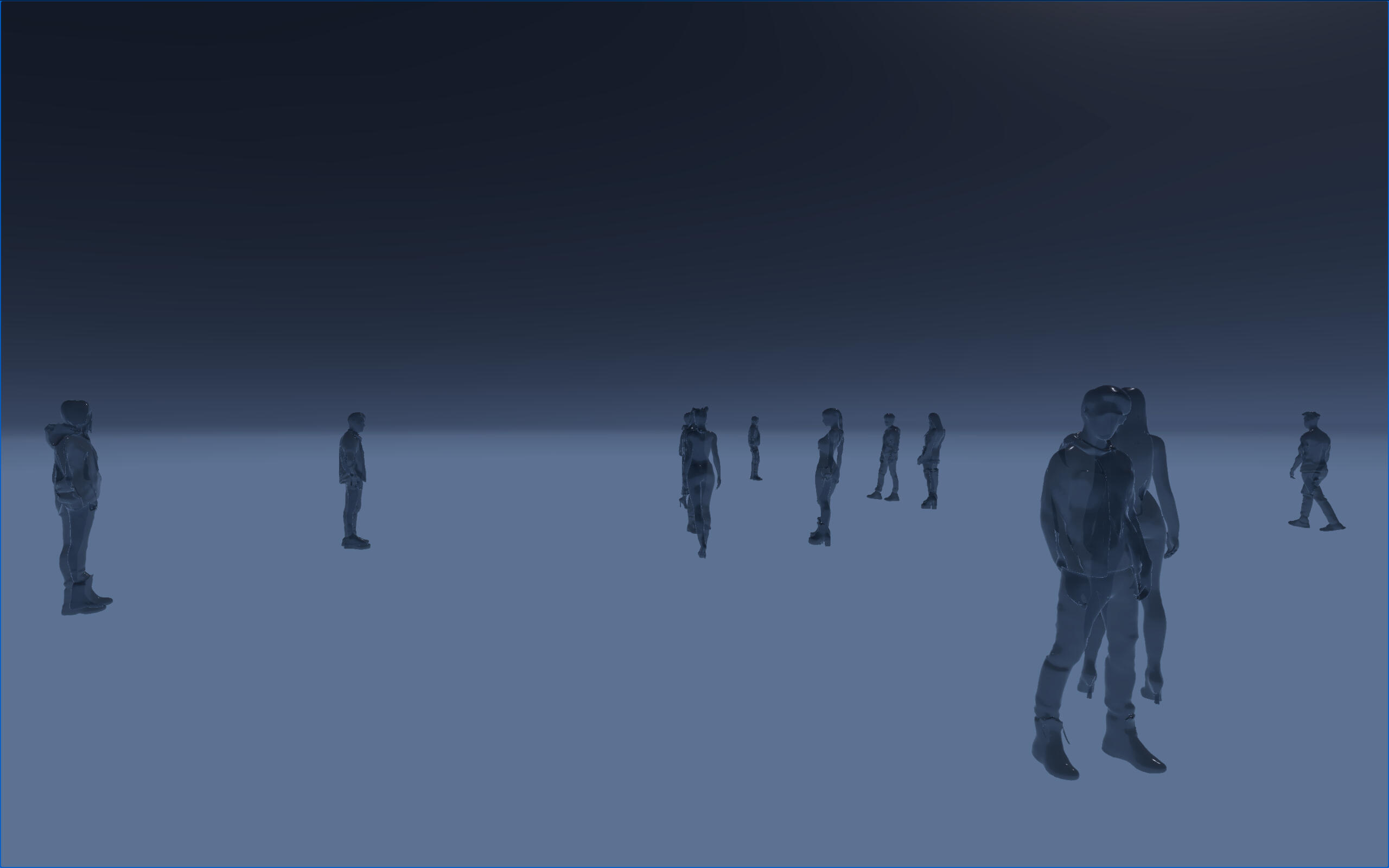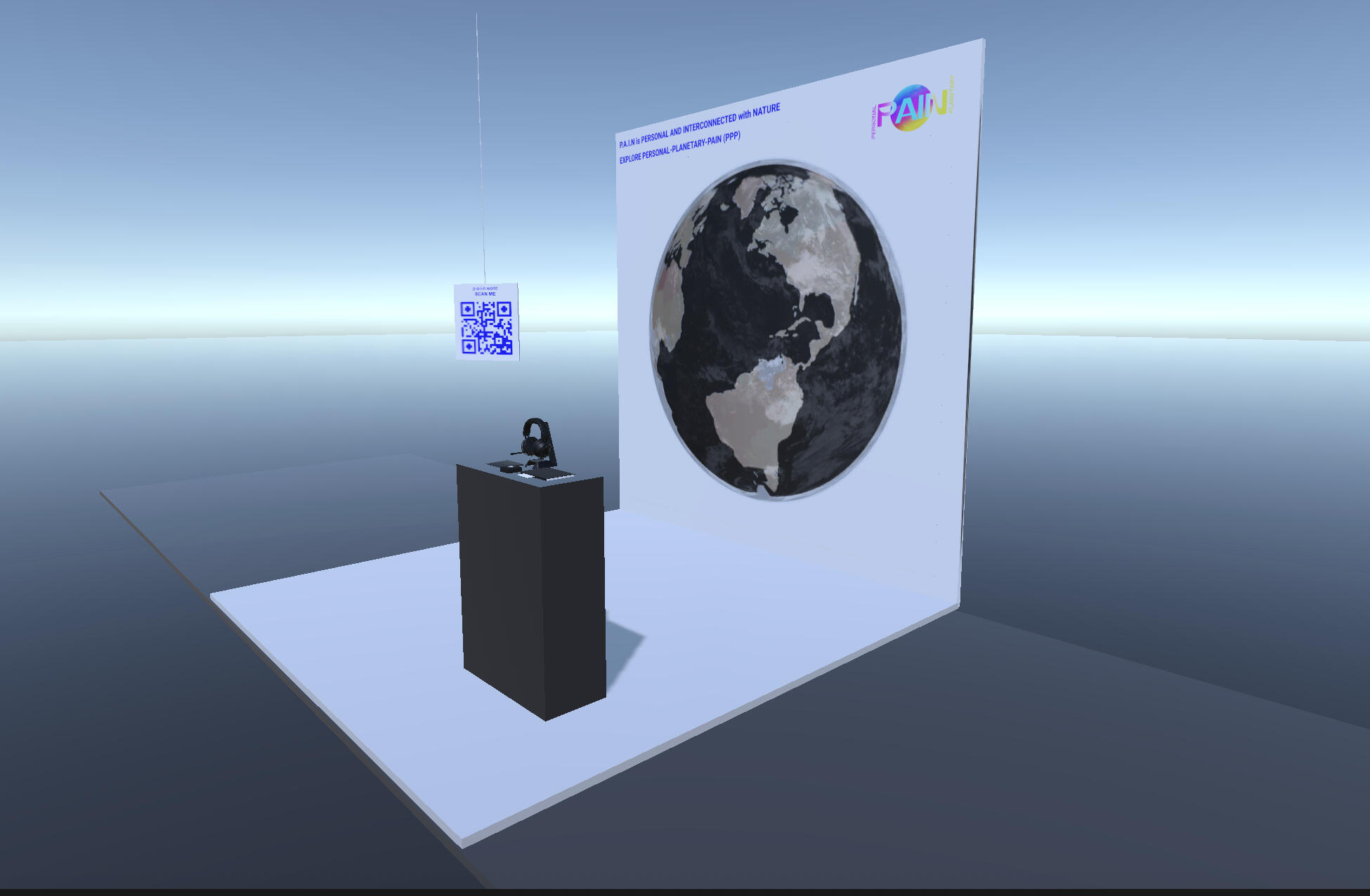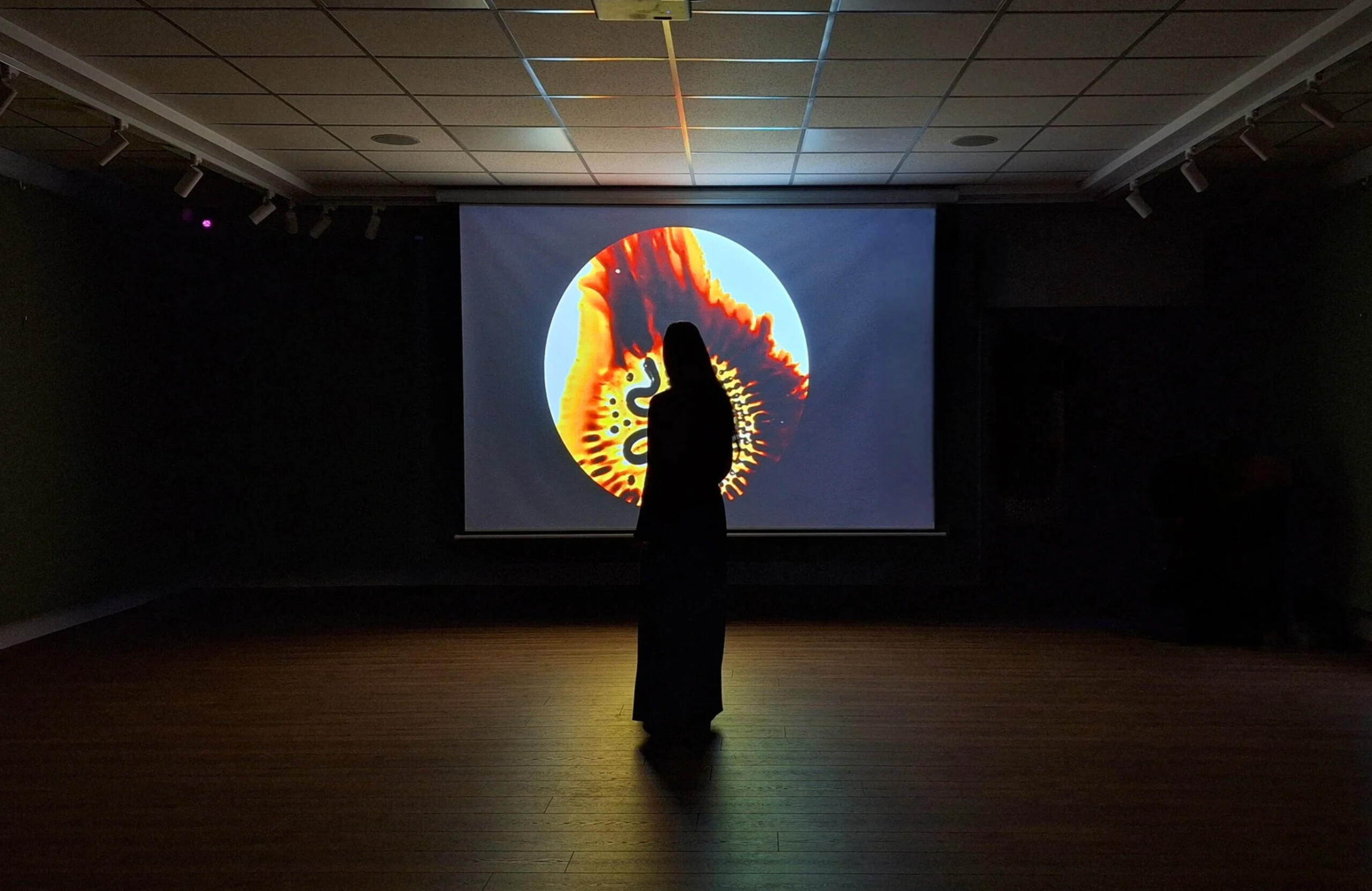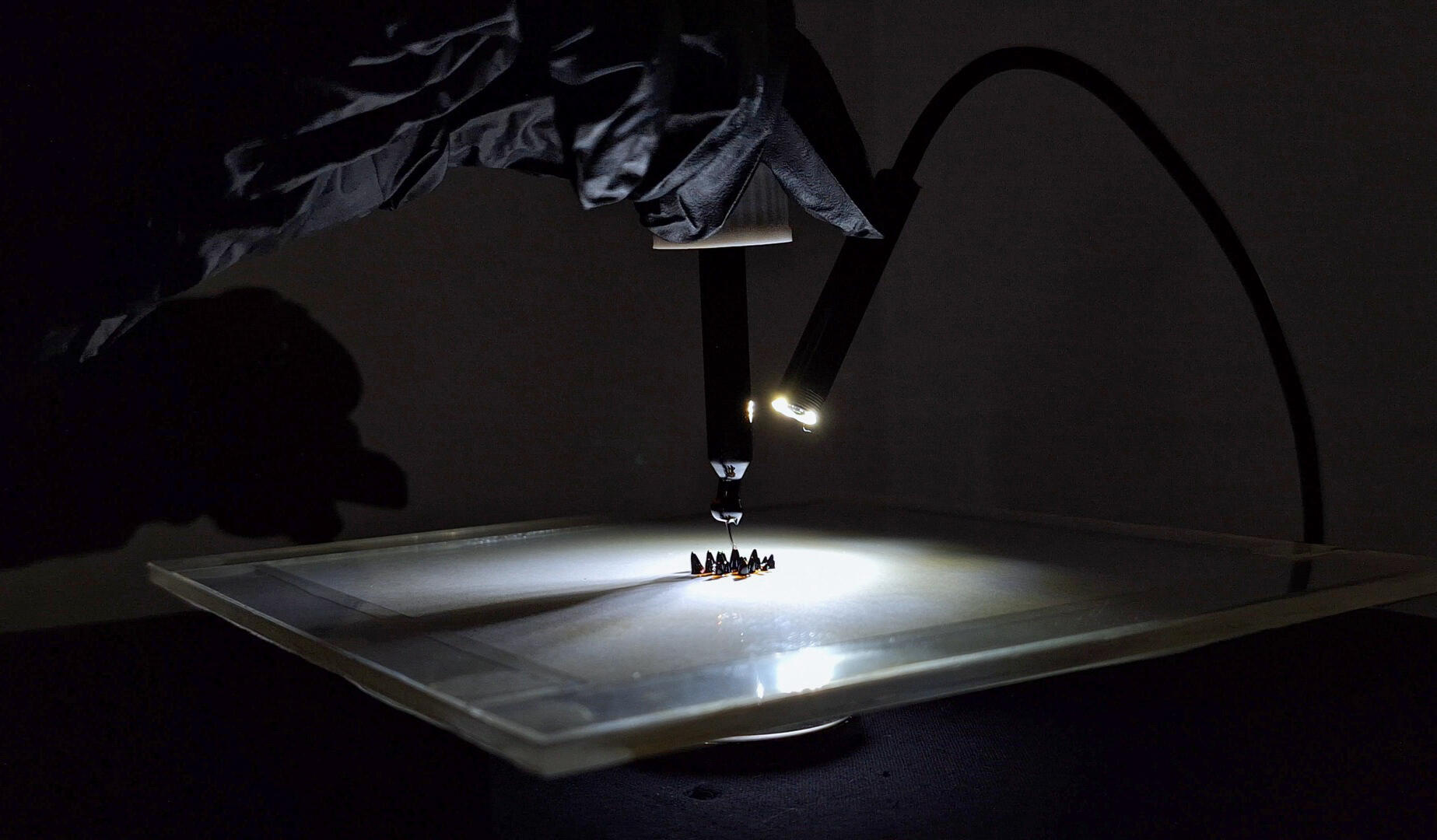© Dora Siafla. All rights reserved.
profile
Dora Siafla (GR b. 2000) is an interdisciplinary artist working across visual and digital media, focusing on data-driven forms, AI systems, video, and user interaction. Her work connects physical materials and computational approaches, investigating how their interplay forms hybrid spaces as platforms for experimental creation.She holds an MA in Audiovisual Arts from the Ionian University, following studies in Visual and Applied Arts at the University of Western Macedonia, where she received two excellence scholarships. Her background is complemented by coursework in computer science and digital methodologies through Harvard’s CS50, MITx, and the University of British Columbia, with ongoing participation in SFPC.Her practice has been presented across international venues, including Ars Electronica, Onassis Stegi x British Council, Boston Cyberarts, NYC Resistor, Winona State University, Athens Digital Arts Festival (ADAF), and the FluxusMuseum Prize Commission for Experimental Video. She has shared her research at international conferences on experimental media, algorithmic sound, AI storytelling, and in IEEE.
EDUCATION2025 Master's Degree in Audiovisual Arts in the Digital Age
Department of Audio and Visual Arts, Ionian University
Grade: Excellent, 9.90/102023 Integrated Master's Degree in Fine Arts
Department of Visual and Applied Arts, University of Western Macedonia
Grade: Excellent, 9.16/10ADDITIONAL EDUCATION (Selected)2025 CS50's Introduction to Artificial Intelligence with Python
Course, Harvard University2023 Understanding the World through Data
Course, Massachusetts Institute of Technology (MITx)2023 CS50's Understanding Technology
Course, Harvard University2023 AI for Teachers
Course, University of British ColumbiaRESEARCH LABS & PROGRAMS (Selected)2025 Transforming Medicine through AI and Art Hackathon
JKU Linz, LBG OIS Center, Ars Electronica Festival2025 Interrogating Computational Approaches to Art
School for Poetic Computation (SFPC)2024 Circular Cultures Design School 2024
Onassis ONX & British CouncilRESEARCH & TEACHING EXPERIENCE2024 Teaching Session (3-hour university course)
‘’Creating Virtual Spaces in Unity: Designing Videogame Environments’’
New Media Laboratory, Department of Visual and Applied Arts, University of Western Macedonia2023 Excellence Scholarship / Research Assistantship (5 months)
Research & visual material development for EU-funded project AgroTour (MR & Gamification)
University of Western Macedonia & Chemical Process Engineering Research Institute2022 Excellence Scholarship / Laboratory Assistantship (10 months)
Assisted in digital media research, visual design, and web development
New Media Laboratory, Department of Visual and Applied Arts, University of Western Macedonia2022 Visual Arts Instructor (Internship)
Taught visual arts & photography in primary school
Department of Visual and Applied Arts, University of Western MacedoniaHONORS & COMMISSIONS2025 Commissioned Work, FluxusMuseum Prize for Experimental Video, Paros, Greece2023 Selected Artist, Photometria International Photography Festival (In Motion Competition),
Ioannina, Greece2019 Featured Image, Photo Contest Online CommunityEXHIBITIONS & FESTIVALS (Selected)2026 Art+Tech Bay Area showcase, Organized by Gray Area, San Francisco, CA
(upcoming)2025 Chronicles of Intimacy, Curated by K:art Studio × Yiming Pi, Pie Factory Margate
Gallery, Margate, UK2025 X Frames Per Space • Different Logics - Shared Questions, Vienna Art Week
Curated by: Melina Steiner, Sebastian Pfeifhofer, Annette Tesarek, Organized by
WEST / LBI-NetMed / VCAS, Vienna, Austria2025 Panic yes/no, Ars Electronica Festival, Linz, Austria2025 CyberFrames, Curated by Valerie Guinn Polgar, Boston Cyberarts, Boston, MA2025 Interactive Show 2025: Internet of Strings, Organized by NYC Resistor, Brooklyn, NY2025 Platforms Project, Avarts, Curated by Artemis Potamianou, Tobacco Factory,
Athens, Greece2025 Love.exe, Organized by New Media Artspace, Baruch College, New York, NY
(Virtual Exhibition)2025 USIPB United States International Poster Biennial, 2025 Edition, US2025 The Forgotten In-Between (Collection 5), Curated by Co-Ex Collaborative, ON,
Canada (Online Exhibition)2025 A Scientific Approach: Visual Documents and Creative Investigation Methods,
International group exhibition organized by LoosenArt, Millepiani Exhibition Space,
Rome, Italy2025 6x6, Rochester Contemporary Art Center (RoCo), Rochester, ΝΥ2024 Wild Media Exhibition & Conference, Organized by International Digital Media and
Arts Association (iDMAa), Curated by Alinta Krauth, Winona State University,
Winona, MN2024 26th International Multimedia Art Festival (IMAF), Curated by Nenad Bogdanovic,
SULUV Gallery, Novi Sad, Serbia2024 Akoysmata 2024: Marathon of Electro-Acoustic Music Projects, 17th Audiovisual
Arts Festival (AVfest), Polytechno, Corfu, Greece2024 Platforms Project, Avarts, Curated by Artemis Potamianou, Tobacco Factory,
Athens, Greece2024 Lightning Era, Curated by Michael Hanna, Aedra Fine Arts, Jersey City, NJ2024 The Wall of Palms, Curated by Beti Trstenjak, Dlan Visual Studio, Maribor, Slovenia2024 20 Years of Creativity Group Student Exhibition, Department of Audio and Visual
Arts, Ionian University, Corfu, Greece.2024 2nd B&W Athens Photography, Organized by Blank Wall Gallery, Serafio City of
Athens, Greece.2023 Flash #3, Curated by John Manno, Decagon Gallery, Brooklyn, NY2023 Kalamata Street Festival, in collaboration with Festival Miden, Kalamata, Greece2023 2nd Video Art Projects, Video Art Miden Festival, Casa Bianca Municipal Gallery,
Thessaloniki, Greece2023 Digital Projections on the City Buildings, Temenus Research Center,
Institute of Audiovisual Arts, Florina, Greece2023 Paint the Lyric, Old Primary School ‘’Kioni’’, Ithaca, Greece2023 Frozen Time: Mount Grammos as a Major Maneuver V, Sereni Mill, Grammos2023 Czech and Greek Heroines, Michael Cacoyannis Foundation, Athens, Greece2022 18th Futuretro, Athens Digital Art Festival (ADAF), Athens, Greece2022 Climate Crisis: Young Artists & Climate Change, Curated by Nina Fragopoulou,
Kefalonia, Greece2022 Trajectories, Primaloria Festival in collaboration with ADAF, Aigio, Greece2022 Rural 1.5C Climate Of Change, Connected We Stand Festival, Thessaloniki, Greece2021 Soul in Laimos: Two Little Seas, Lemos & Milionas, Prespa, Greece2021 Networks, Temenus Research Center, Institute of Audiovisual Arts, Florina, Greece2021 14th Audiovisual Arts Festival (IAVA), Department of Audio and Visual Arts, Ionian
University (Online Platform)2020 Visual Arts e-Pandemic Towards a creative diffusion of the arts, University of
Western Macedonia, in collaboration with the Archaeological Museum of FlorinaTALKS & PRESENTATIONS2025 Hackathon Showcase, Transforming Medicine through AI and Art, Ars Electronica
Festival, Postcity, Linz, Austria2024 Artist Talk, International Digital Media and Arts Association (IDMAA), Wild Media
Exhibition & Conference, Winona State University, Winona, Minnesota2024 Presentation, ‘’Artificial Threads,’’ Circular Cultures Design School, Onassis
Foundation & British Council, Athens, Greece2023 Artist Talk, ARSIS Kozanis, Art Sessions 03, Kozani, Greece2022 Presentation, ‘’Time Fields,’’ International Conference XENAKIS 22, Xenakis
Workshop, Nafplio, Greece.PUBLICATIONSTsioutas, K., Doumanis, I., Tiligadis, K., Dalezios, N., & Siafla, D. (2025). Evaluating Emotional
Responses to Experimental Video Art. In Proceedings of the 12th IFIP International Conference
on New Technologies, Mobility and Security (NTMS 2025), Paris, France. IEEE.
https://doi.org/10.1109/NTMS65597.2025.11076746 (peer-reviewed)Siafla, D. (2023). The Ever-Changing Landscape/Returning. Paper presented at the Walking Arts
Encounters/Conference (WAC 23), Prespa, Greece. Proceedings forthcomingMEDIA & PRESS COVERAGE2025 Artist Spotlight, Co-Ex Collaborative Social Media Campaign, Online2024 Selected Work, Superpresent Magazine, Volume 5, No. 1, pp. 67, Houston, TX2023 Featured Artist, Together, Issue 68, pp. 8, Kozani, Greece2021 Group Feature, The New New, Online Tribute to Art and Audiovisual Schools in
Greece, Festival Miden2020 Group Interview, The Art Newspaper, Issue 251, p. 28, Athens, GreeceADDITIONAL RELEVANT EXPERIENCE2023 Conference Organizing Committee Member
Walking Arts Encounters/Conference (WAC 23), Prespa, Greece2021 Conference Organizing Committee Member
Walking Arts Encounters/Conference (WAC 21), Prespa, Greece2021 Exhibition Mediation Assistant
Thessaloniki International Fair (TIF), Thessaloniki, GreecePROFESSIONAL AFFILIATIONS2023 Member, Chamber of Fine Arts of Greece (ΕΕΤΕ)
© Dora Siafla. All rights reserved.
Last Seen in the Lobby

Last Seen in The Lobby, 2025
Virtual Environment
Many people turn to video game communities to connect, express themselves, and find a sense of belonging. These spaces are supposed to be free environments where different voices and experiences can exist. But censorship and moderation often work against this idea. ''Last Seen in the Lobby'' is a virtual space filled with ghost-like avatars. Each avatar represents a real person who was silenced or pushed out of gaming spaces. When you move closer, text bubbles appear, showing real statements from online platforms where users explained why they were removed or muted. Some people spoke about mental health, identity, or political views. Others defended someone else or simply shared personal feelings. Even simple words became reasons for bans. This work wants to show how moderation systems and social dynamics decide who gets to speak and who disappears. It keeps visible the words of people who were erased from places meant to be open and shared.
Transforming Medicine Through AI and Art
Planetary-Personal-Pain (PPP), 2025
Interactive App/Website
Ars Electronica, LBG OIS Center, JKU LIFT_C
‘’Planetary-Personal-Pain’’ (PPP) takes the form of an interactive pain map, visualizing the entanglement of ecological destruction, socio-economic fragility, and human suffering. Drawing on data from social media expressions of pain, medical health datasets, GDP statistics, and environmental records, phantom scars emerge as craters on the Earth’s surface, each sonified through the five elements of Traditional Chinese Medicine - Wood, Fire, Earth, Metal, and Water. Participants’ narratives of pain are integrated into this planetary cartography, encouraging reflection on the ongoing impact of ecological and health crises. Users share their personal narratives of pain, adding depth to the collective and lingering pain corresponding to environmental distress in different countries.
PPP was developed during the Hackathon 2025, a three-day program organized by @jkulinz’s LIFT_C, @arselectronica, and @ludwigboltzmanngesellschaft's OIS Center. The work was presented at the Ars Electronica Festival 2025 in Linz, as part of the showcase "Transforming Medicine through AI and Art."Team: Dora Siafla, Hollis Hui, Julia Guthrie, Jack Heseltine, Ines Gerard-Ursin, Lukas Troyer, Mary Maggic, Mathieu Mahve-Beydokhti, Michael Artner, Péter Velősy.


The Living Code of Biosemiosis

The Living Code of Biosemiosis, 2024-25
Interactive Installation
Diploma Thesis, Department of Audio & Visual Arts, Ionian University
The work draws from the principles of biosemiotics, specifically the idea that life is based on codes and signs.At its core is the cell, around which the installation is developed. This research suggests an understanding of ''semiosis'' as an intrinsic process of the body, arising through its continuous relation to the surrounding environment. The world is shaped by continuous exchanges of signals, many of which remain unseen to human perception. Cells respond to chemical signals, plants transmit information through their roots, and animals communicate through movements, sounds, and colors. If every structural element carries an imprint of meaning within it, then the body, the environment, and information form an inseparable field.The interactive structure is activated by touching a biometric sensor for an extended period. Within a small square frame, a black droplet of magnetic fluid transforms, forming shapes reminiscent of cells. As the form settles, it leaves behind a trace of a residual mark, akin to blood. Above the droplet, a small camera captures these transformations. The images are projected on a large scale onto the wall. Simultaneously, the changes in the form of the droplet cell are translated into sound, creating an acoustic environment that evolves in real-time.

Circular Cultures Design School 2024
Artificial Threads, 2024
Generated Text Prototype
Onassis Stegi x British Council (Onassis ONX)
This practice explores how cultural traditions change over time, following a storytelling process similar to the evolution of oral histories.It uses two artificial intelligence systems to generate a sequence of narratives: starting with a traditional story, one AI continues it, and another AI further expands the narrative. This recursive process highlights the small changes, reinterpretations, and patterns that emerge as stories pass through different "voices", both human and artificial. The work examines collective memory, emphasizing the fluid nature of storytelling, where no story remains fixed.It raises questions such as: Who tells the story? Can AI be considered a cultural author?This prototype was developed at the Circular Cultures Design School, an initiative of @onassis.stegi Foundation and @onassis.onx in collaboration with the @britishcouncil.
Elements: A Walking Path
Elements: A Walking Path, 2022
Video Art, 1:00
Walking becomes a way of reading the land.The piece concerns a route in a natural landscape, where during the course, material was collected through recording applications, and some of the information that emerged was used for the audiovisual material: the shape of the route, numbers, words, and symbols.Walking as a practice reveals how the real world is perceived subjectively. In the process, even the body itself functions as a medium, detecting the place, processing it, and subsequently producing the stimuli received. Each region ceases to be something objectively defined and is shaped according to the experiences of the individual in it.Τhe video challenges conventional mapping and explores post-digital landscapes where data, memory, and place are continuously redefined.
Under the Microscope
Under the Microscope, 2023
Video Art, 2:00
Nothing truly disappears-matter only shifts, dissolves, and reforms. What we discard, what erodes, what decays does not cease to exist; it transforms and is absorbed into systems that long predate us.The materials collected for this study come from sites marked by transition: landscapes of extraction, spaces of abandonment, and ground altered by time or force. Organic matter is broken down, and repurposed into soil, while remnants of human production linger, resistant to time. Under the microscope, these materials reveal their liminality-bodies dissolving into landscapes, structures reduced to particles, traces of presence suspended between past and future. The images captured through a microscopic camera expose a threshold where material existence is neither fixed nor absent but in continuous negotiation with time. In a world of relentless consumption and decay, what does it mean to return, and what remains irreversibly altered?
Route: Way to a Place
Route: Way to a Place, 2022-23
Video Projection-Installation
Diploma Thesis, Department of Fine & Applied Arts, UoWM
In recent years, the term aesthetics has undergone a shift, shaped by the dynamics of digital culture and online communities. A growing, internet-born understanding positions aesthetics as an assemblage of images, colors, objects, music, and textual styles; capable of evoking a particular mood, social function, or sense of identity. This contemporary usage is highly subjective, contingent on personal taste, cultural context, and media exposure, and has become especially prevalent in platforms such as Tumblr, TikTok, and Instagram, where visual coherence is often a substitute for deeper narrative.This shift is not neutral. What appears to be a playful or even superficial layering of stylistic fragments is, in many cases, a response to the fragmentation of identity and meaning in a post-digital landscape. The algorithmic curation of these experiences often collapses the boundary between authenticity and performance, with aesthetics functioning as soft architectures of emotional alignment. This shift informs the installation’s structure. Built with five translucent rice papers, the space receives projections that generate volumes and layered surfaces. Writing incorporates textures and elements from digital environments, such as software terminology, glitches, program fonts, pixels, icons, windows, GPS graphics, RGB systems, waveforms, and 3D wireframes. Together, they form a coded visual online language.
CC: Connection/Catalyst
CC: Connection/Catalyst, 2024
Interactive Installation
In an era where inertia becomes a mechanism of complicity and observation replaces action, this work employs an interactive system to bring the Bystander Effect to life in real time. As viewers approach, the particles in the space react, shifting, accelerating, or becoming disrupted, mirroring the delicate balance between engagement and detachment. Presence alone is enough to disturb the balance, yet absence is just as decisive. Without participation, inertia prevails. If no one steps forward, nothing changes. The work explores the interplay between individual agency and collective movement, shaping an evolving environment where participation or the lack of it leaves a visible impact.At its core, a circular segment of the projection displays messages like 'Are you aware of your role?’, encouraging visitors to reconsider their place within the social fabric. Its form is dictated by the presence or absence of engagement, just as social dynamics are shaped by collective will or passive silence. The work leverages the natural limitation of the distance sensor: when multiple viewers approach simultaneously, the measurement becomes unstable or imprecise. This technical ambiguity is deliberately integrated into the system, reflecting the social confusion and diffusion of responsibility central to the Bystander Effect.
Lasianthus
Image: GenBank
Lasianthus, 2024
Sound Art, 6:40
Who deciphers, who encodes, and who listens?This work sonically translates the DNA of plant species from the Rubiaceae family, using their extreme genetic variability as a compositional foundation. The high degree of diversity, especially in the non-coding regions of chloroplast DNA, prevents stable molecular classification and leaves certain genera within the family scientifically unresolved. The project reflects on forms of life that resist categorization, stabilization, and ownership. The composition amplifies irregularity, giving voice to what science often treats as noise or error. Ongoing cases of biopiracy targeting plant genomes demonstrate how conflicts over genetic material remain entangled with broader systems of control.Complete chloroplast DNA sequences, sourced from public databases, were algorithmically mapped into sound, assigning each character to a distinct sonic event. The piece preserves the raw, linear structure of the genetic code, allowing the instability and ambiguity of biological material to emerge audibly. Through the transformation of biological volatility into sound, the piece engages with the theme of life’s unruliness as a form of refusal against taxonomic, legal, and commercial systems. Listening becomes an encounter with a form of existence that refuses to conform, occupying a space beyond fixed narratives or structures.
Audio Sample
visual.sync
visual.sync, 2024
Print, 50x50 cm
The work investigates the eye as a biological interface exposed to processes of capture and computation. In 2024, a documented demonstration of security flaws in avatars within VR/MR environments raised concern, showing that even minute ocular micro-movements can be converted into exploitable cues for inference and monitoring. Positioning the body within regimes of modeling and mapping makes visible the tensions that emerge around biometric extraction, protocols of consent, and the politics of embodiment in digital systems.Within this framework, the coupling with iris motion reconfigures the avatar as a relay of transmission, where unconscious signals take on a function that exceeds mere visual depiction.
Closeness Index
Closeness Index, 2025
Virtual Space
By constructing a synthetically intimate setting with an AI system, the work examines how machine-based memory organizes linguistic signals associated with closeness.Over several days, a sequence of affectively weighted, chat-based texts was exchanged to simulate conditions of interpersonal interaction. After this exchange, the model was prompted to determine which entries to retain. Rather than mirroring human logic or narrative continuity, the selection process reflected internal computational criteria, including lexical recurrence, tonal markers, and compositional patterns.The virtual space presents the model’s output as a mapped arrangement. Drawing from how neural networks organize data in multidimensional spaces, the environment spatially manifests the model’s internal selection process, making abstract memory structures tangible. A fixed spherical form holds the center, indicating presence and maintaining a low typing sound triggered by proximity. Around it, the selected texts are organized by thematic criteria extracted from the model’s selection logic. Each wall hosts one parameter and its associated fragments.Serving as an experimental framework, the design setting facilitates the expression of the model’s internal logic as a blueprint, separating memory from dialogue, and encouraging reflection on the nature of artificial remembrance.



























































